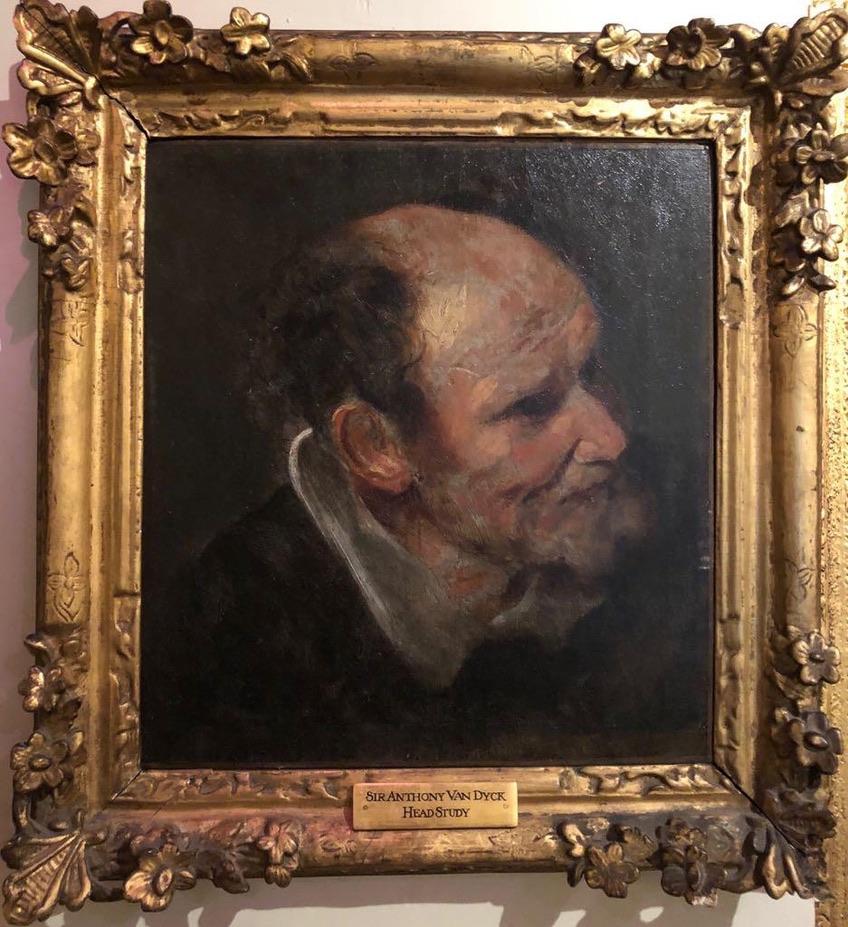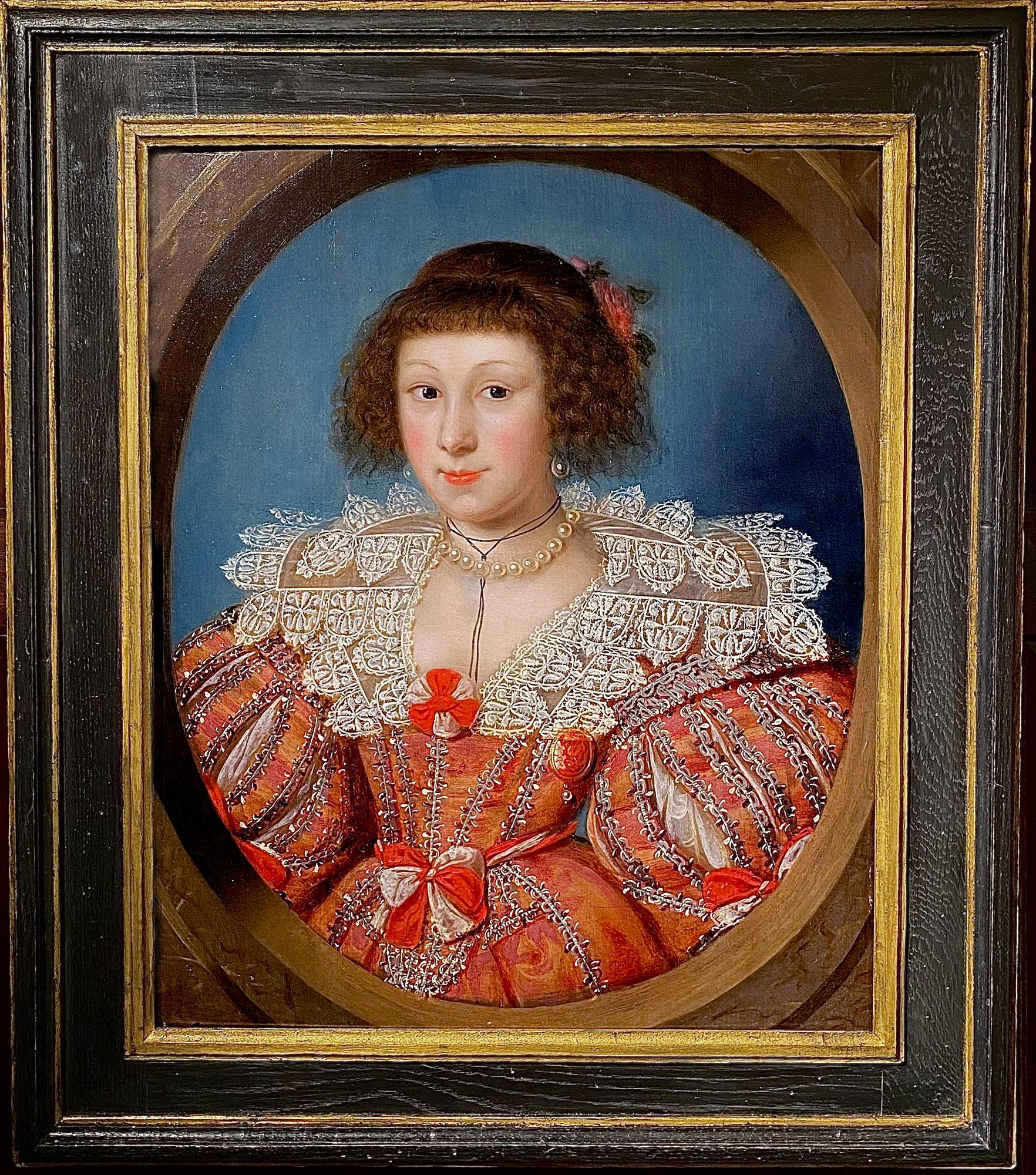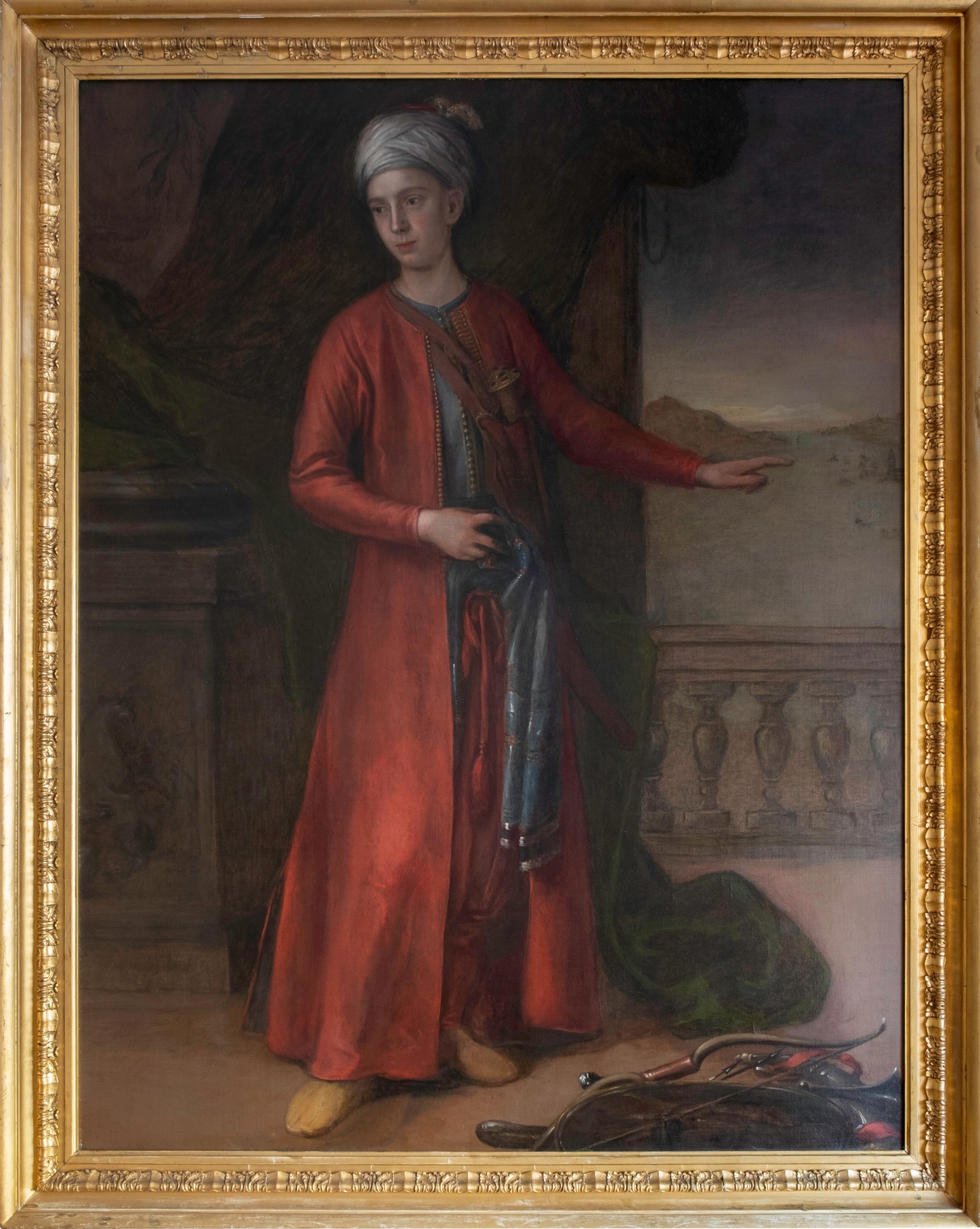
Portrait of Charles Stewart Parker - British 18thC art Old Master oil painting
View Similar Items
Want more images or videos?
Request additional images or videos from the seller
1 of 12
Attributed to Henry Raeburn Portrait of Charles Stewart Parker - British 18thC art Old Master oil painting1799
1799
About the Item
- Creator:Attributed to Henry Raeburn
- Creation Year:1799
- Dimensions:Height: 46 in (116.84 cm)Width: 38 in (96.52 cm)Depth: 2 in (5.08 cm)
- Medium:
- Movement & Style:
- Period:
- Condition:
- Gallery Location:London, GB
- Reference Number:1stDibs: LU85318796242
About the Seller
5.0
Platinum Seller
These expertly vetted sellers are 1stDibs' most experienced sellers and are rated highest by our customers.
1stDibs seller since 2018
400 sales on 1stDibs
More From This SellerView All
- Portrait of a Lady with Pink Bow - British c 1820 Old Master art oil paintingBy Sir Thomas LawrenceLocated in London, GBThis lovely British Old Master portrait oil painting is attributed to circle of Sir Thomas Lawrence. Painted circa 1820 it is a seated half length portrait of a beautiful lady in a b...Category
1820s Old Masters Portrait Paintings
MaterialsOil
- Portrait of Robert Monypenny with Racket - British 18th century art oil paintingBy Thomas BeachLocated in London, GBThis lovely British 18th century Old Master oil painting is attributed to the manner of Thomas Beach. The sitter is Robert Monypenny (1771-1834) aged seven. He is the youngest son of...Category
18th Century Old Masters Portrait Paintings
MaterialsOil
- Portrait of a Lady with a Blue Bow - British 18thC art Old Master oil paintingLocated in London, GBThis superb British 18th century Old Master portrait oil painting is attributed to Matthew William Peters. Painted circa 1780 it is a fine half length portrait of a woman gazing to her left. She has a lovely blue bow and sash on her dress. The sympathetic detail in her face is sublime. A really wonderful 18th century Old Master portrait. Matthew William Peters was known for his late 18th century portraits which had both the influence of Sir Joshua Reynolds and Thomas Gainsborough. Provenance. Lincolnshire estate. Condition. Oil on canvas 30 inches by 25 inches unframed and in good condition. Has has restoration. Frame. Housed in an ornate gilt carved swept period frame, 40 inches by 35 inches framed and in good condition. Matthew William Peters (1742-1814) was an English portrait and genre painter who later became an Anglican clergyman and chaplain to George IV. He became known as "William" when he started signing his works as "W. Peters". Peters was born in Freshwater, Isle of Wight, the son of Matthew Peters (born at Belfast, 1711), a civil engineer and member of the Royal Dublin Society; by Elizabeth, the eldest daughter of George Younge of Dublin. The family moved from England to Dublin when Peters was young. Peters received his artistic training from Robert West in Dublin; in 1756 and 1758 he received prizes from the first School of Design in Dublin. In 1759, he was sent by the Dublin Society to London to become a student of Thomas Hudson and won a premium from the Society of Arts. The group also paid for him to travel to Italy to study art from 1761 to 1765. On 23 September 1762 he was elected to the Accademia del Disegno in Florence. Peters returned to England in 1765 and exhibited works at the Society of Artists from 1766 to 1769. Beginning in 1769, Peters exhibited works at the Royal Academy. In 1771 he was elected an associate and in 1777 an academician. He returned to Italy in 1771 and stayed until 1775. He also probably traveled to Paris in 1783–84, where he met Léopold Boilly, Antoine Vestier, and was influenced by the work of Jean-Baptiste Greuze. On 27 February 1769, Peters became a freemason, and he was made the grand portrait painter of the Freemasons and the first provincial grand master of Lincolnshire in 1792. In 1785, he exhibited portraits of the Duke of Manchester and Lord Petre as Grand Master at the Royal Academy exhibition. According to Robin Simon's article in the Oxford Dictionary of National Biography, no British contemporary had such an Italian manner of painting as Peters, reflecting the old masters he copied. Many of Peters' works were erotic and although these works did not damage his career, according to Simon, Peters later regretted these when he became an ordained clergyman in 1781. He served as the Royal Academy's chaplain from 1784 to 1788, at which time he resigned to become chaplain to the Prince of Wales. In 1784, Peters was awarded the living of Scalford, Leicestershire by Charles Manners, 4th Duke of Rutland. In 1788, the Dowager Duchess gave him the living at Knipton, at which time he also obtained that at Woolsthorpe. These livings were near to Belvoir Castle...Category
18th Century Old Masters Portrait Paintings
MaterialsOil
- Portrait of a Girl with Basket of Flowers -British 18thC Old Master oil paintingLocated in London, GBThis charming 18th century Old Master cartouche portrait oil painting is attributed to the circle of Philip Mercier. Painted circa 1740 the composition is a three quarter length portrait of a young girl holding a wicker basket of flowers. She is clothed in a white dress and beautiful blue silk shawl and is situated in a landscape. A very lovely British Old Master portrait oil painting. Provenance. Christies. Condition. Oil on canvas, 30 inches by 25 inches and in good condition. Frame. Housed in an ornate gilt carved 18th century frame, 38 inches by 33 inches and in good condition. Philippe Mercier (also known as Philip Mercier; 1689-1760) was a French painter and etcher, who lived principally and was active in England. He was born in Berlin of French extraction, the son of a Huguenot tapestry-worker. He studied painting at the Akademie der Wissenschaften of Berlin and later under Antoine Pesne, who had arrived in Berlin in 1710. Later, he travelled in Italy and France before arriving in London—"recommended by the Court at Hannover"—probably in 1716. He married in London in 1719 and lived in Leicester Fields. He was appointed principal painter and librarian to the Prince and Princess of Wales at their independent establishment in Leicester Fields, and while he was in favour he painted various portraits of...Category
18th Century Old Masters Portrait Paintings
MaterialsOil
- Joseph interpreting Dreams - Italian Old Master 17thC religious art oil paintingLocated in London, GBThis lovely 17th century Old Master religious oil painting is from the Italian School. The subject is Joseph in prison interpreting the dreams of Pharoah's Baker and Butler. The bars...Category
17th Century Old Masters Portrait Paintings
MaterialsOil
- Portrait of Anna de Hooghe - Flemish art Old Master portrait oil paintingBy Jacob Ferdinand Voet 1Located in London, GBThis strong Flemish Old Master portrait oil painting is attributed to Ferdinand Voet. The sitter is Anna De Hooghe, the fourth wife of artist Ludolf Bakhuizen (1631-1708), a German-born Dutch painter, draughtsman, calligrapher and printmaker. He was the leading Dutch painter of maritime subjects after Willem van de Velde the Elder and Younger left for England in 1672. He also painted portraits of his family and circle of friends. Painted circa 1660 Anna is standing profile but turned to the viewer/artist with her hand to her heart. She is set in a landscape at twilight. A really lovely painting and superb example of Dutch art. It is recorded in the RKD archives with N Maes signature LL - since removed through restoration. Provenance. The estate of George Way. Archive RKD Condition. Oil on canvas, 38 inches by 34 inches unframed and in good condition. Frame. Housed in a fine period carved frame, 46 inches by 42 inches framed and in good condition. Jacob Ferdinand Voet or Jakob Ferdinand Voet (1639-1689) was a Flemish portrait...Category
17th Century Old Masters Portrait Paintings
MaterialsOil
You May Also Like
- Portrait of a Lady with a ChiqueadorLocated in New York, NYProvenance: Torres Family Collection, Asunción, Paraguay, ca. 1967-2017 While the genre of portraiture flourished in the New World, very few examples of early Spanish colonial portraits have survived to the present day. This remarkable painting is a rare example of female portraiture, depicting a member of the highest echelons of society in Cuzco during the last quarter of the 17th century. Its most distinctive feature is the false beauty mark (called a chiqueador) that the sitter wears on her left temple. Chiqueadores served both a cosmetic and medicinal function. In addition to beautifying their wearers, these silk or velvet pouches often contained medicinal herbs thought to cure headaches. This painting depicts an unidentified lady from the Creole elite in Cuzco. Her formal posture and black costume are both typical of the established conventions of period portraiture and in line with the severe fashion of the Spanish court under the reign of Charles II, which remained current until the 18th century. She is shown in three-quarter profile, her long braids tied with soft pink bows and decorated with quatrefoil flowers, likely made of silver. Her facial features are idealized and rendered with great subtly, particularly in the rosy cheeks. While this portrait lacks the conventional coat of arms or cartouche that identifies the sitter, her high status is made clear by the wealth of jewels and luxury materials present in the painting. She is placed in an interior, set off against the red velvet curtain tied in the middle with a knot on her right, and the table covered with gold-trimmed red velvet cloth at the left. The sitter wears a four-tier pearl necklace with a knot in the center with matching three-tiered pearl bracelets and a cross-shaped earing with three increasingly large pearls. She also has several gold and silver rings on both hands—one holds a pair of silver gloves with red lining and the other is posed on a golden metal box, possibly a jewelry box. The materials of her costume are also of the highest quality, particularly the white lace trim of her wide neckline and circular cuffs. The historical moment in which this painting was produced was particularly rich in commissions of this kind. Following his arrival in Cuzco from Spain in the early 1670’s, bishop Manuel de Mollinedo y Angulo actively promoted the emergence of a distinctive regional school of painting in the city. Additionally, with the increase of wealth and economic prosperity in the New World, portraits quickly became a way for the growing elite class to celebrate their place in society and to preserve their memory. Portraits like this one would have been prominently displayed in a family’s home, perhaps in a dynastic portrait gallery. We are grateful to Professor Luis Eduardo Wuffarden for his assistance cataloguing this painting on the basis of high-resolution images. He has written that “the sober palette of the canvas, the quality of the pigments, the degree of aging, and the craquelure pattern on the painting layer confirm it to be an authentic and representative work of the Cuzco school of painting...Category
17th Century Old Masters Paintings
MaterialsCanvas, Oil
- Portrait of Senator Bartolomeo Panciatichi by Santi di Tito (1574)Located in PARIS, FRThis recently rediscovered portrait of Santi di Tito depicts a Florentine senator, with a letter in his hand indicating that the painting was executed in 1574 when the sitter was 66 years old. On the basis of these clues, it is tempting to view it as a portrait of Bartolomeo Panciatichi, who was painted some thirty years before by Bronzino (1503 - 1572). While the treatment of the hands recalls the Florentine tradition of Mannerist portraits, the comparison with Bronzino's portrait illustrates Santi di Tito's search for greater realism, despite the stereotyped composition. 1. Santi di Tito, Counter-Reformation painter and portraitist Santi di Tito was the great painter of the Florentine Counter-Reformation. He proposed a new artistic language that broke away from Mannerism. Little is known about his training in Florence (perhaps alongside Bronzino or Baccio Bandinelli), but this period of training enabled him to join the Company of Saint Luke, the guild of Florentine painters, in 1554. Between 1560 and 1564, Santi di Tito spent time in Rome, where he frequented the workshop of Taddeo Zuccari. This stay had a fundamental influence on his work, thanks to the discovery of the late work of Raphael, but also his encounters with the painters Francesco Salviati and Federico Barocci. Around 1565, Santi di Tito returned to Florence, where he remained until the end of his life, dividing his talents between the creation of important religious paintings and countless portraits. He became one of the city's leading painters, distinguishing himself, in particular, in the creation of large religious compositions in which the spirit of the Counter-Reformation was reflected. In 1568, Santi di Tito became a member of the Confraternity of Saint Thomas Aquinas...Category
16th Century Old Masters Portrait Paintings
MaterialsPoplar, Oil
- Stunning 17th Century Oil Painting - Study of a Head of a ManBy Anthony van DyckLocated in London, GBStudio of Sir Anthony Van Dyck (1599-1641, Flemish) Study of a Head of Man Circa 1627-32, Van Dyck’s second Antwerp period Oil on paper, laid down on canvas Dimensions 15 x 14 inches...Category
17th Century Old Masters Portrait Paintings
MaterialsOil
- Portrait of a Girl, 17th Century English School Old Masters OilBy Gilbert JacksonLocated in London, GBGilbert Jackson English Active: 1620 - 1650 Portrait of a Girl Oil on panel, signed upper left and Inscribed upper right Image size: 24 ½ x 20 inches Contemporary style hand made...Category
17th Century Old Masters Portrait Paintings
MaterialsOil
- 18th C. Portrait of the 4th Earl of Sandwich a View of Constantinople BeyondLocated in London, GBJohn Montagu, 4th Earl of Sandwich (13 November 1718 – 30 April 1792) Attributed to George Knapton (1698-1778) Dressed in the Turkish manner, stand...Category
18th Century Old Masters Figurative Paintings
MaterialsOil
- Portrait of Gentleman, Thomas Bruce, Earl of Elgin c.1638 Manor House ProvenanceLocated in London, GBTitan Fine Art present this picture which formed part of a historic collection of an English aristocratic family, Lord and Lady Sandys at their magnificent baroque and Regency Grade-...Category
17th Century Old Masters Portrait Paintings
MaterialsOil, Wood Panel
Recently Viewed
View AllMore Ways To Browse
Old Antique Cane Chairs
Stewart Of Scotland
George Iv Coat
Antique King George Chair
Parker Henry Painting
Ra Chair
Attributed To Henry Raeburn
Old Sovereign
Girl Peering
Princess Of Wales
Basketball Player
Portrait Of A Noble Lady
Angel Mosaic
Richard Lane
Guido Reni Oil Painting
Antique Oval Oil Portrait
1800 American Oil Paintings
William Henry Earl

















